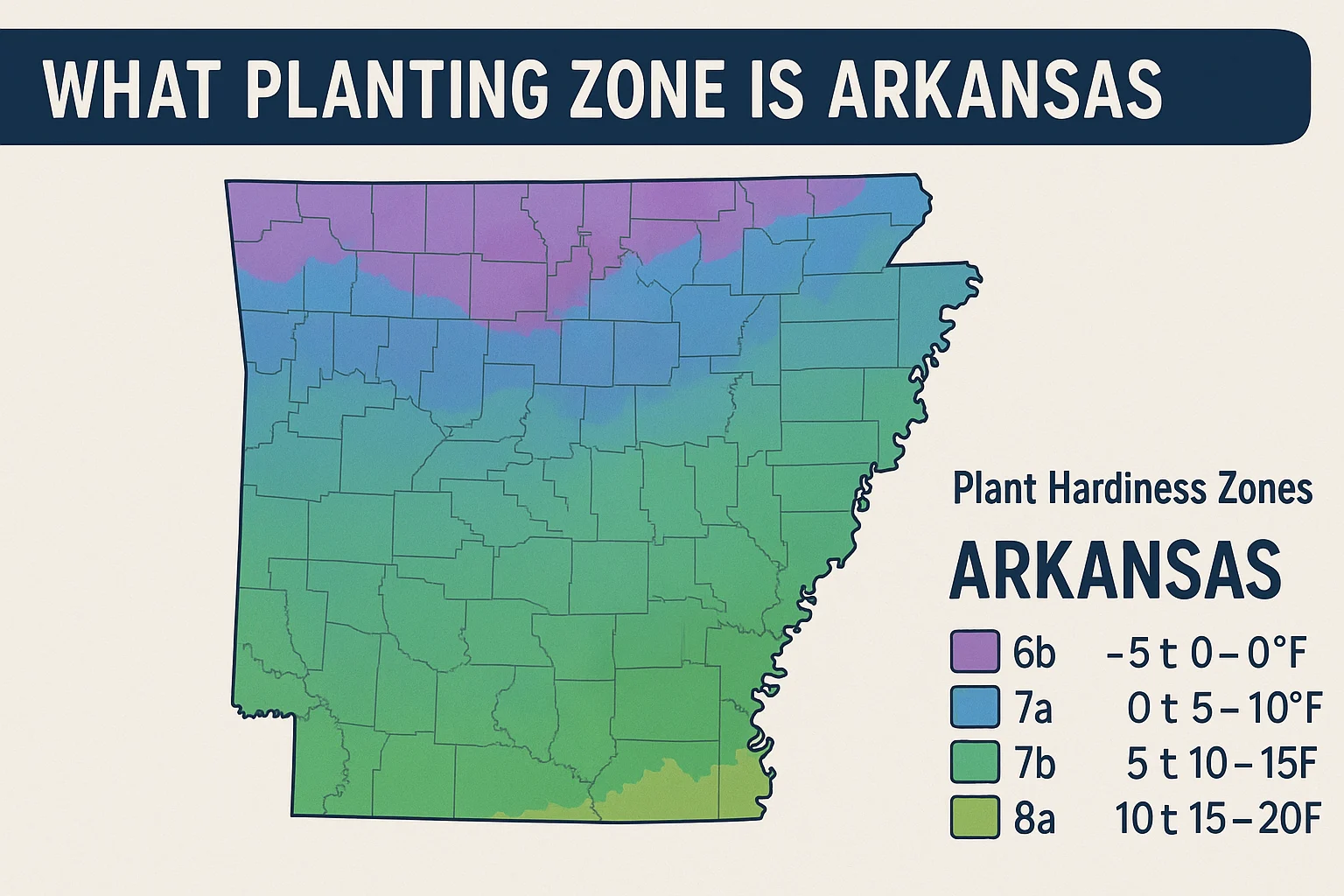What Planting Zone is Arkansas?[Map, Cities, and Growing Tips]

If you’re planning a garden, food forest, or landscape project in Arkansas, the first thing you need to know is your USDA Plant Hardiness Zone — also known as your planting zone. Why? Because Arkansas’s growing success depends heavily on knowing your local climate, especially winter lows that affect perennial plants.
So what planting zone is Arkansas? Let’s break it down by region, city, and gardening goals — so you know exactly what will thrive in your backyard.
🌱 What Planting Zone is Arkansas?
Arkansas spans USDA Zones 6b through 8a, depending on where you live:
| Region | USDA Zone |
|---|---|
| Northwest Arkansas (e.g., Fayetteville, Bentonville) | Zone 6b |
| Central Arkansas (e.g., Little Rock, Conway) | Zone 7b |
| Southern Arkansas (e.g., El Dorado, Texarkana) | Zone 8a |
These zones are determined by the average annual minimum winter temperature. That means gardeners in northern Arkansas may experience temperatures as low as -5°F, while gardeners in the southern part of the state enjoy milder winters around 15–20°F.
📍 Arkansas Planting Zones by City
Here’s a city-by-city breakdown of planting zones across the Natural State:
| City | Planting Zone |
|---|---|
| Fayetteville | Zone 6b |
| Bentonville | Zone 6b |
| Fort Smith | Zone 7a |
| Little Rock | Zone 7b |
| Conway | Zone 7b |
| Hot Springs | Zone 7b |
| Pine Bluff | Zone 8a |
| Texarkana | Zone 8a |
| Jonesboro | Zone 7a |
| El Dorado | Zone 8a |
These zones can vary slightly depending on microclimates, but this gives a reliable foundation for choosing plants and planning your growing calendar.
🌡️ Why Planting Zones Matter in Arkansas
Arkansas is a diverse state with mountains, valleys, and wetlands — and that means the climate can change dramatically from one county to the next.
Knowing your planting zone helps you:
- Select perennials that won’t die off during winter
- Plan when to plant vegetables based on frost dates
- Understand how much cold your garden is likely to face
- Choose trees, shrubs, and flowers suited to your climate zone
🧪 Example: Peppers in Zone 6b vs. Zone 8a
Let’s say you want to grow jalapeño peppers.
- In Zone 6b (e.g., Fayetteville), you’ll need to wait until early May to plant outdoors due to frost risk.
- In Zone 8a (e.g., Texarkana), you might start as early as late March or early April — and potentially grow a second round in late summer.
That’s 6+ extra weeks of growing time for southern gardeners, which can mean larger yields and longer harvest windows.
📅 Arkansas Planting Calendar by Zone
| Crop Type | Zone 6b Start | Zone 7b Start | Zone 8a Start |
|---|---|---|---|
| Leafy Greens | Mid-March | Early March | Late February |
| Tomatoes/Peppers | Early May | Mid-April | Late March |
| Perennials | Early spring or fall | Fall preferred | Fall is best |
Always check your local frost dates, especially if you live in higher elevations or valleys, where temperatures may dip lower than surrounding areas.
🌾 Arkansas Gardening Tips by Zone
Arkansas’s humid subtropical climate supports a wide range of plants, but it also brings challenges like sudden cold snaps, humidity-driven diseases, and heavy clay soils in many areas.
✅ Do:
- Add organic matter to improve clay-heavy soils
- Use raised beds or containers in low-drainage zones
- Mulch deeply to manage heat and suppress weeds
- Choose zone-appropriate fruit trees like figs, persimmons, and peaches
❌ Avoid:
- Planting too early — spring frosts can still surprise you, even in southern Arkansas
- Ignoring pests — aphids, squash bugs, and spider mites thrive in warm, humid air
- Overwatering — heavy rains can rot roots if drainage isn’t managed
📍 Don’t Rely on City Alone — Check Your Zip Code
Although city zones give a good estimate, planting zones can shift within 10–20 miles. Your elevation, proximity to rivers, and even urban heat effects can push your microclimate up or down a full half-zone.
To be precise, enter your ZIP code into the official USDA Plant Hardiness Zone Map to get a hyperlocal zone assignment.
🧮 Helpful Calculators for Arkansas Gardeners
Planning is everything — especially when Arkansas weather likes to surprise you. Use these calculators to save time, money, and effort:
- Soil Volume Calculator – Estimate how much soil your bed or pot needs.
- Plant Spacing Calculator – Avoid overcrowding and maximize yield.
- Indoor Plant Watering Calculator – Perfect for Arkansas houseplant lovers and porch growers.
🙋 FAQs About Arkansas Planting Zones
What is the best planting zone for vegetables in Arkansas?
Zone 7b is ideal for diverse gardening — long growing seasons with a balanced risk of frost. It gives you flexibility to grow cool- and warm-weather crops with relatively few limitations.
Can I grow citrus trees in Arkansas?
Citrus trees don’t survive outdoor winters in most of Arkansas. In Zone 8a, you may get away with container-grown citrus if you bring it inside during cold snaps.
When is the last frost in Arkansas?
- Zone 6b: Mid-April
- Zone 7b: Late March to early April
- Zone 8a: Mid-to-late March
✅ Final Thoughts: Know Your Zone, Grow Smarter
Whether you’re planting a vegetable patch, fruit trees, or native perennials, knowing your Arkansas planting zone is the first step toward long-term success. From the Ozarks to the Delta, the right plants in the right place make all the difference.
So go ahead — check your zone, mark your frost dates, and start building your dream garden rooted in your unique Arkansas climate.
